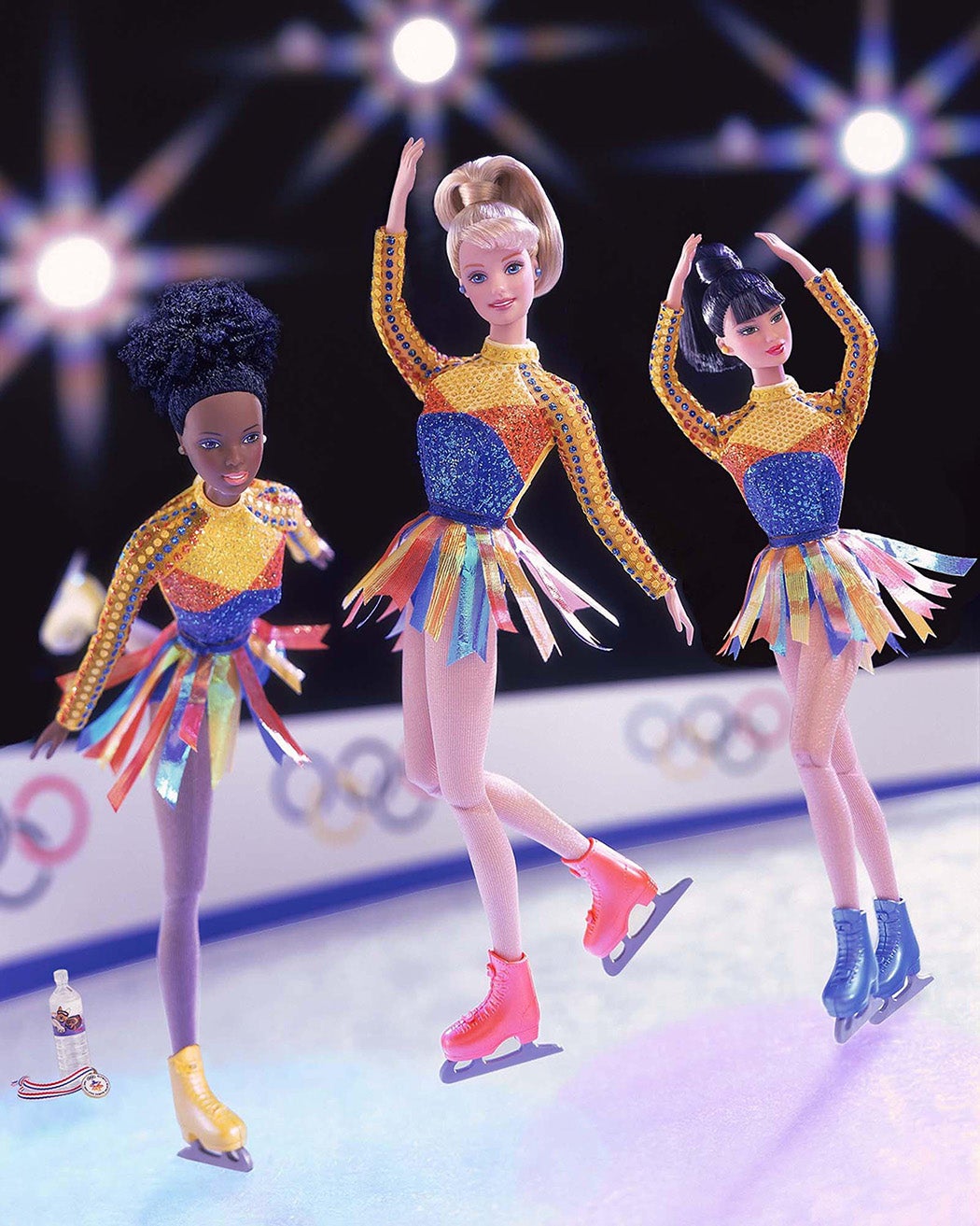Since she was created in 1959, Mattel’s Barbie doll and her descendants have been fodder for feminist researchers, sociologists, gender theorists, and other academics. As we all probably know by now, the doll was invented by Ruth Handler, who noticed her daughter Barbara playing with paper dolls and giving them adult narratives and roles. At the time, most dolls looked like infants, but Handler saw a gap in the market for adult dolls for girls, and the rest is Barbie history. Initially a teen fashion doll, Barbie has gone through six decades of transformations and rebranding, becoming a cultural icon over the years and appearing as an astronaut, doctor, physicist, and just about any other professional you can think of.
Critics of Barbie have written about the doll’s commodification of women’s empowerment, the unrealistic beauty standards she set, the lack of racial inclusion in the Barbie universe, and lots more. Greta Gerwig’s 2023 Barbie movie seems to draw on the rich history of Barbie and her critics. The annotated reading list below captures some of the myriad academic and scholarly research about Barbie. As always, the linked research on JSTOR is free to access and download for JSTOR Daily readers. Just follow the red letter ![]() .
.

Girlhood, Gender, and Sexuality
Linda Wason-Ellam. “‘If Only I Was Like Barbie.’” Language Arts, vol. 74, no. 6, 1997, pp. 430–37.
It’s impossible to understand Barbie without acknowledging the toy plays a big part in young girls’ construction of their sense of self. This ethnographic study investigates how young girls construct gendered identities and meanings through exchanges between visual and written texts, including Mattel’s book version of Cinderella, where Barbie takes on the titular role.
Catherine Driscoll. “CHAPTER FOURTEEN: Girl-Doll: Barbie as Puberty Manual.” Counterpoints, vol. 245, 2005, pp. 224–41.
Bringing together two relevant cultural texts for pre-adolescent girls, Catherine Driscoll considers dominant gender discourses through analyses of Barbie dolls and puberty manuals in the early 2000s as influential manifestations of the “tween” space in public and popular representations of girlhood.
Claudia Mitchell. “Charting Girlhood Studies.” Girlhood and the Politics of Place, edited by Claudia Mitchell and Carrie Rentschler, Berghahn Books, 2016, pp. 87–103.
A good summary of what has been accomplished or found so far in girlhood studies, which has often drawn on how girls understand gender and power dynamics through playing with Barbie.
Louise Collins, et al. “We’re Not Barbie Girls: Tweens Transform a Feminine Icon.” Feminist Formations, vol. 24, no. 1, 2012, pp. 102–26.
Based on the insights collected from a research workshop for middle-school girls, this article asks what girls feel, think, and hope when playing with Barbie. Drawing on the insights middle-school girls delivered when discussing and reflecting on the constructions of female bodies and feminine identities in popular culture, Collins et al suggest that consumers are not simply vessels for consumption—they can be critical engagers of the products they consume.
Michael A. Messner “Barbie Girls versus Sea Monsters: Children Constructing Gender.” Gender and Society, vol. 14, no. 6, 2000, pp. 765–84.
How do toys help children make meaning of gender? In this article, Michael A. Messner examines this question through an analysis of children’s interactions with pop culture.
Anna Wagner-Ott. “Analysis of Gender Identity Through Doll and Action Figure Politics in Art Education.” Studies in Art Education, vol. 43, no. 3, 2002, pp. 246–63.
Using action figures and dolls as pedagogical tools, this article explores how art educators can engage young people in a critical dialogue to uncover preconceived ideas, attitudes, and values inherent in gendered objects.
Becky Francis. “Gender, Toys and Learning.” Oxford Review of Education, vol. 36, no. 3, 2010, pp. 325–44.
Drawing on the claim that children learn gender through playing, Becky Francis conducts evaluated selected toys—including some Barbie accessories—to identify the gender discourses reflected in the children’s choice of toys.

Whiteness and Race
Maureen Trudelle Schwarz. “Native American Barbie: The Marketing of Euro-American Desires.” American Studies, vol. 46, no. 3/4, 2005, pp. 295–326.
A particular concern of Barbie critics is the brand’s focus on and centering of whiteness, which the brand has addressed through the creation of ethnically diverse versions of the doll. In this in-depth analysis of Native American Barbie dolls and what they teach girls—and society more broadly—about Native American cultures in the United States, author Maureen Trudelle Schwarz argues that Barbie sanitizes the horrors of colonialism and Indigenous oppression.
Elizabeth Chin. “Ethnically Correct Dolls: Toying with the Race Industry.” American Anthropologist, vol. 101, no. 2, 1999, pp. 305–21.
Examining the claim that providing more diverse toys is a progressive solution to white hegemony, this anthropological study with a group of working class, Black ten-year-old children complicates the politics of representation and inclusion.
Nina Cartier. “Black Women On-Screen as Future Texts: A New Look at Black Pop Culture Representations.” Cinema Journal, vol. 53, no. 4, 2014, pp. 150–57.
In this article, Nina Cartier offers a short but important critique of Nicki Minaj’s Black Barbie, along with other representations of Black womanhood onscreen.
Margaret Hunter and Alhelí Cuenca. “Nicki Minaj and the Changing Politics of Hip-Hop: Real Blackness, Real Bodies, Real Feminism?” Feminist Formations, vol. 29, no. 2, 2017, pp. 26–46.
Examining Nicki Minaj’s body of work, particularly her embodiment of her Black Barbie persona, the authors argue that Minaj’s offers a brand of feminism that is highly marketable because it merges a language of critique and oppression.
Okafor, Chinyere G. “Global Encounters: ‘Barbie’ in Nigerian Agbogho-Mmuo Mask Context.” Journal of African Cultural Studies, vol. 19, no. 1, 2007, pp. 37–54.
Beyond being an American doll, the product of Barbie was exported across the world, thus spreading its message across borders. In this article, Chinyere G. Okafor writes about the doll’s impact on Nigerian beauty standards through the image of the Agbogho-mmuo mask of the Igbo ethnic group. The encounter between these two beauty standards is the site of a global image-making network, the author suggests, and its discussion allows for an analysis of the globally empowered Barbie doll and her impact on Nigerian culture.

Marketing Barbie
Marlys Pearson and Paul R. Mullins. “Domesticating Barbie: An Archaeology of Barbie Material Culture and Domestic Ideology.” International Journal of Historical Archaeology, vol. 3, no. 4, 1999, pp. 225–59.
Drawing on the history of Barbie since the 1950s and the distinct “single career girl” marketing strategy employed by Mattel, the authors of this article offer a systematic examination of Barbie fashions, accessories, and playsets, which they argue reveals several distinct phases in the domestic symbolism associated with the doll. By tracing the history of Barbie accessories, the authors are able to pinpoint changes in Barbie’s domestic image over the last 40 years.
Erica Rand. “Making Barbie.” Barbie’s Queer Accessories, Duke University Press, 1995, pp. 23–92.
Delving deep into the history of Barbie and Mattel’s uneven and deflecting history around the character, Erica Rand writes about the erasure of Ruth Handler from the history of the doll’s creation by Mattel (something that has been curiously rectified in Gerwig’s film) and the gender meanings made by the company that invented Barbie.

Postfeminism, Pop-feminism, and Other Critical Lenses for Classroom Discussions of Barbie
Rosalind Gill. 2007. “Postfeminist Media Culture: Elements of a Sensibility.” European Journal of Cultural Studies 10 (2): 147–166.
To understand the complexity of Barbie, it’s important to understand the existence of postfeminism and how it manifests through media culture. In this article, Rosalind Gill suggests a few approaches to engaging with postfeminist pop culture in critical and feminist ways.
Jess Butler. “For White Girls Only? Postfeminism and the Politics of Inclusion.” Feminist Formations, vol. 25, no. 1, 2013, pp. 35–58.
In this article, Jess Butler delves into the lack of intersectional perspectives in the literature on postfeminism, which she argues privileges a white, middle-class heterosexual subject. By drawing on the image of pop star Nicki Minaj, Butler suggests an intersectional approach to producing knowledge about postfeminism.
Angela McRobbie. “Postfeminism and Popular Culture: BRIDGET JONES AND THE NEW GENDER REGIME.” Interrogating Postfeminism: Gender and the Politics of Popular Culture, edited by Yvonne Tasker and Diane Negra, Duke University Press, 2007, pp. 27–39.
In this article, Angela McRobbie analyzes the postfeminist messages of the Bridget Jones franchise to emphasize the “double entanglement” of being a woman, where a productive home and work life are desirable to complete a modern woman’s life.
Alice Leppert. “‘Can I Please Give You Some Advice?’ ‘Clueless’ and the Teen Makeover.” Cinema Journal, vol. 53, no. 3, 2014, pp. 131–37.
While we probably won’t have to wait that long for academic critical engagements with Gerwig’s Barbie, reading critiques of similar films might help us think about it critically. In this article, Alice Leppert analyzes a common trope in teen films through the film Clueless: the teen makeover that makes the unpopular nerd into a popular girl.
Weekly Newsletter
Shauna Pomerantz et al. “GIRLS RUN THE WORLD? Caught between Sexism and Postfeminism in School.” Gender and Society, vol. 27, no. 2, 2013, pp. 185–207.
A study on how teenage girls understand sexism in a society that teaches them that gender is no longer a question of concern. By exploring Canadian girls’ experience with the postfeminist belief that sexism doesn’t exist, the authors suggest that postfeminist narratives make it difficult for teenage girls to identify and name gender discrimination.
Carrie Smith Smith and Maria Stehle. “Popfeminism.” The German Quarterly, vol. 91, no. 2, 2018, pp. 216–27.
In this short article, the authors define the concept of “pop feminism” in a capitalist society, a critical perspective to understand Barbie as part of a postfeminist, neoliberal system of power and hierarchies.
Michelle S. Bae. “Interrogating Girl Power: Girlhood, Popular Media, and Postfeminism.” Visual Arts Research, vol. 37, no. 2, 2011, pp. 28–40.
Challenging the usual critiques of girl power, Michelle S. Bae offers an alternative approach for interpreting the concept — which directly implicates Barbie and the toy’s history with women’s empowerment. Understanding that the dominant discourse on girl power is still located in an essentialist frame of white Western hegemony, Bae uses the original criticisms of girl power as a starting point for arguing that girl power might be interpreted as subversive to patriarchy and are marked by contradictions.
Support JSTOR Daily! Join our new membership program on Patreon today.







